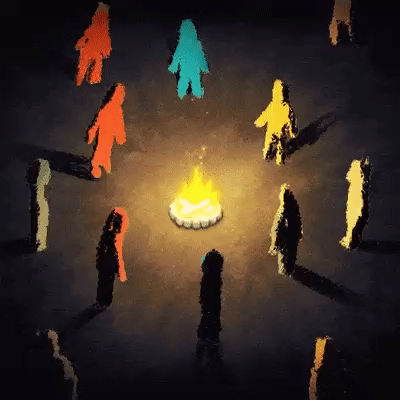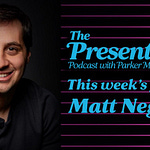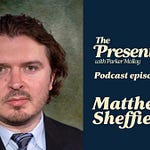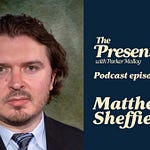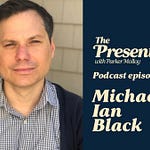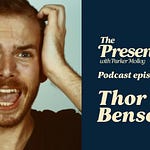Welcome to the Present Age podcast. I’m your host Parker Molloy.
Joining me on today’s show is animator and crypto art creator Bryan Brinkman. His work has appeared at places like The Tonight Show, Saturday Night Life, and even Sesame Street. Today, he’s going to teach me a bit about NFTs.
Parker Molloy: So, joining me today on the podcast is Bryan Brinkman. Hello.
Bryan Brinkman: Hello, Hey Parker.
How's it going?
It's going very well.
So, I wanted to have you on the podcast to talk to you about your art and your work, which I really like and enjoy. And also the one thing that I don't understand, but I want to understand, NFTs. Can you help me understand what an NFT is and how that applies to the art world, basically?
I can do my best to try.
All right.
Because it's an ever-growing description because every week there's something new happening in the space. But just to start out, I would say an NFT stands for Non-Fungible Token. Kind of the idea behind it is that you can authenticate digital assets through the blockchain. And so, as a way of storing imagery or content. It's a way of saying, "Hey, I possess this digital asset," and that gives you the ability to trade it and resell it or do whatever you want with it. And so that's kind of the basic idea around what an NFT is, but then what that asset can be is exploding into a million possibilities.
Yeah, I was reading something the other day about how people have other applications of the same blockchain technologies. Someone was saying, "Oh yeah, one day we could have contracts and deeds to houses and stuff like that on there". And that's really interesting. And I think that part of the issue is that a lot of people just struggle to understand the concept, because for instance, like in NFT might be something like a video or a GIF, or just a still image. Right?
And people might think, okay, well, why would I buy this when I can just look at it anytime I want, I can make my own copy of it. I could just pull up a website that has this on it and look at it. For people who are thinking about trying to kind of explore that space as either a creator or someone who just wants to get involved and support artists. I guess that's another big thing, which I understand that that is definitely one of the reasons someone would want to pay for something as opposed to just looking at it on the internet.
I think that's a good question. The first thing that comes to people's minds, when they say it is, why would I pay for JPEG when I can just download it or screenshot it? And I think that same idea can be applied to a lot of art. Why does any art have value? It's because there's a group of people that all agree it has value, and that gives it value.
I think you can kind of look at the NFT collectible art market as being similar to what baseball cards were in the 90s. Those cards are printed for probably a penny on a piece of cardboard paper, but the value is whether a lot of people altogether go, "Hey, this Michael Jordan rookie card is worth more than this other card."
And so I think it kind of falls into the same thing as that the NFT is just a medium and a canvas for people to create on. And the idea of I could just screenshot that, well, you can't go and sell a screenshot, but you can authenticate that you own the original copy of an NFT and someone will want to buy that.
And that's really interesting. And that's a good point. I mean, the only real differences, the fact that there's a physical object to hold onto with, for instance, with baseball cards, which funnily enough, I was recently thinking about maybe getting back into collecting baseball cards because every once in a while, when the world gets too chaotic, I try to pick up a new hobby. So I don't just explode on Twitter or something like that.
And a few years back it was comic books. I was like, I'm going to just get really into comic books and that's been helpful. And then it was video games, and it's all these like going back to my childhood kind of things. And so I think baseball cards is the next kind of going down and just looking into the state of that industry right now is really interesting as well. I don't know, I remember growing up and it'd be like, here's this one card, this is the card for this player for this year.
And now it's like, “Well this one, if it has a blue border, it's worth more than if it has a multicolored.” And I'm just like, man, it's so complicated now.
Well, the sports card, yeah. The sports card industry's kind of changed a lot recently too. I've been looking at like, they have like column like penny cards. When you buy these boxes and they have pieces of jerseys and autographs and all these amazing hand drawn pieces of cards and stuff, they've really upped the trading card game to keep up with kind of the collector mentality in recent years. Which is something I wasn't very aware of until like the past year.
Yeah. And just the day I was looking at Topps, the trading card company. They have a section on their website that's now just Topps and NFTs. And it's kind of that same idea of trying to be like, yeah, you can own this rare whatever. And then there are some people who sell like a penguin or something. And I'm trying to understand that. And I don't know, I feel like I'm just like a million years old.
No, I think there's, in my mind there's kind of two worlds of NFT collecting right now. There's the art side. And then there's the kind of the collectible side and the collectible side falls into that kind of sports card mentality where there's high volume and there are big communities backing it. And with the penguins, there's 10,000 of those penguins. And so having a feature in the New York Times will give all these people excited and the prices fluctuate, and it falls into more of like kind of a stock market mentality where there's kind of this liquidity to these collectibles. Whereas the art side falls into a slightly different category where it's more of like artists building communities around their work and their style. And that falls into kind of like the auction house world and the New York gallery world versus kind of like the sports card collectors.
So there's all these different entry points. And I would say like a lot of the space grew because of a website called NBA Top Shot that came out about a year ago and kind of brought that sports card, collecting mentality into the space. And then all these people did it. They kind of got a sense and they started to wrap their minds around, "Hey, these digital assets hold value". And then they started looking elsewhere. And so that they kind of branch off into what else there is, because I think it was [inaudible] who's an artist in the space. He made a tweet the other day. That was like, "When you used to meet a celebrity, you'd ask for an autograph, but now you ask for a selfie," and that mentality of what has more value to people these days? Is it the digital experience or is it this physical thing you hold? I think that's changing rapidly, especially with video game skins, and how you manage your digital content and video game worlds. For instance, I think translates very one-to-one with NFT world.
That's yeah. That's a good point.
Kids, these days. They care more about digital assets than putting paintings on their wall. They, they want to show paintings on their phone that they can show their friends.
Yeah. And that's really interesting. And I mean, one way I have been trying to wrap my head around that over the past several months. And one thing that I've seen as a criticism of NFTs and just things that involve crypto generally is like the energy consumption of that. But it, everything seems so unclear when it comes to the environmental effect of any of this. Do you have any thoughts on that? I mean, I'm sure you have thoughts on that.
Yeah. I mean I think it was around January, after I'd been in the space for a year, that article kind of came out written by this guy named Memo and it was kind of this jarring account of how much energy could be consumed at a maximum amount, if everything travels all these places and burns all this energy. And there's certainly different blockchains that consume different types of energies. And there's these arguments of kind of proof of work versus proof of stake. Ethereum is not the best at it. And they are actively trying to move to this new Ethereum 2.0, that will reduce this all by like 99%, but it's a slow process. So in the meantime, there's a lot of these kinds of like, they call them side chains where people can kind of mint on these layers, two solutions that take up less energy.
But after that article came out, a lot of the NFT websites made commitments to offset their carbon emissions. So, I mean I've seen in the six months or so I guess it's been maybe eight months since that article came out, that has been a key point of almost every project is to offset that as artists. I did my calculations and offset it and I've done charities to raise money for that. And so there's a lot of ways you can kind of work towards that in the short term while they're kind of finding solutions in the long-term.
And then a lot of artists that really feel strongly about it have moved to other blockchains, like Tezos, there's a website called hic et nunc, which is a very silly name, but I consider it to be kind of like the Brooklyn indie comic NFT site. So there's a lot of really cool art there, that's a lot more affordable and they call it clean NFTs. And so there's a lot of different ways people are kind of working to get around that in the short term, but there is certainly a lot of criticisms that are, I think are valid about Bitcoin and other blockchains that aren't working towards solutions in the longterm.
Yeah, that's it, it's one of those things where I feel like the backlash to it was so swift where it was, if you buy an NFT, you're destroying the planet and you'd be like, whoa, I don't think that that is necessarily fair. Just saying that to people. I feel like that kind of scared a lot of people away from like really participating in this as either a consumer or an artist. And hopefully, that kind of over time will-
I think the math and the calculations were all based on worst-case scenarios. Looking at it, the idea that miners are only going to consume pure energy isn't necessarily true because they're going to want to be using renewable energy just for their own profits’ sake. And a lot of mining happens on kind of solar power and renewable energy consumption. So I think there was a swift backlash and then people started to kind of understand that minting one NFT isn't the equivalent of an entire day of London's energy consumption. Yeah. So I think people started to kind of look into it, figure out what the accurate amount was. I mean, I had places reaching out to me asking me to help them like figure out calculations. Like I'm not a math scientist, but I can do my best to help, but yeah-
“Please animate this and also do a bunch of very complicated math equations for it.”
But yeah, I think in the end, I think it's somewhere in between the two, it's not, it's not urgent issue and it's also not a non-issue it's somewhere in between and you have to kind of work towards doing your best to address it as you can.
Yeah, definitely. And so one of the things I wanted to kind of ask you about was just all of your other work that you've done over the years. I mean, just looking at your website, you have Tonight Show, Saturday Night Live, Sesame Street, a music video for The Good Life, one of my favorite bands, which is-
We're both big Tim Kasher fans.
Yeah. That's very, very cool. Cause I totally forgot you did that one, which it's a good video it's for "The Troubadour's Green Room", right?
Yeah, yeah, yeah, no, that was such a fun one to do because they basically reached out to me and they were like, do you want to do this video? Here's three songs from the new album. And I just kind of sat and closed my eyes and listened to the songs until imagery came about. And they just let me kind of dream up visuals and kind of make something on my own. And so they were very hands-off and they just let me have fun with it. It was a blast cause I'm such a huge fan. I'm originally from Omaha, Nebraska, so I grew up a big Saddle Creek Records fan.
I mean, I'm from Illinois, so it's not too far away, but also grew up a big fan of Saddle Creek. Every band that was on there, I would go out and buy their albums as soon as it came out. Any of the bands that Tim Kasher would be in or Connor Oberst or any of the guys from The Faint, all of those bands are so good.
I love The Faint, that they were my entry point to Saddle Creek when I was young, seeing those concerts were such a blast. I mean, they still are, anytime they come around town, I try to see them. But yeah, I think that kind of career path I took, I kind of went to school for animation. And then I found work kind of working in advertising and TV. I worked on some animated series, like the Life and Times of Tim, which was this very small, HBO cartoon, but it was a lot of fun to work on. So I kind of did all these paths before eventually kind of working. I worked at The Tonight Show for like eight years, but in my free time, I would try to do music videos. I would try to do posters for concerts. I would do these pop culture, art gallery shows in LA.
And I was always trying to kind of like find ways to be creative because it was just like, that's my hobby. That's what I love doing. And then once kind of NFTs came around, it was like, oh, I no longer have to worry about turning my digital work into physical work to sell. This is a perfect platform for me to create animations. And I don't have to make short films for film festivals anymore. I can just make little short things that tell stories. And I found it to be just like the perfect amalgamation of all these things I've been trying to do for years. Cause I mean, I'm going to date myself, but when I was in high school, I was creating little flash cartoons for newgrounds.com, uploading them and then getting excited when people would be like, I like this one or I get upset when they say I hate this one, but it was that same concept where it's been years later I'm still doing the same thing where I'm just kind of making whatever I want to make and then I put it out there and I see what people think.
Yeah. And it's really cool. And I love your style just generally speaking. The colors that you use, the really weird-ass kind of... I mean, just on your website under on the crypto page, there's one of the animations is like a person being ripped in half, but it's weird because it's not in this really gruesome way. It's just sort of like, Hey... unzip, zip back up kind of thing. And I just really enjoy that. How would you describe your art style? Also, just anyone listening to this, you can go over to my website, readthepresentage.com and I'll be sure to include some of your Tweets that have your images and stuff in there, so they can see what on earth we're talking about.
Giselle Flores recently said I was a conceptual cartoonist, which I thought was very funny and kind of fitting, but I think the concept behind when I joined the NFTs was I had been doing these kinds of gallery shows and a lot of curators and people in the scene kept telling me "If you want to be a successful artist, you have to do the same style over and over because that's what galleries expect you to do when they put you in a show, they want you to do the work that you're famous for, because that's what sells". And I was kind of hated that mentality of like putting yourself into a corner, especially early on in your artistic career. I mean, I was living out in LA shortly after college and I just thought that's the worst way to get stuck in a style like so early.
And so when I started doing NFTs, I kind of wanted to break away from that. I saw it as an experimental area to do whatever in. And so my thesis behind my art was I'm just going to stick with a color scheme and then I can do whatever style I want. I can do 3D, I can do 2D cartoons, I can do paintings. As long as they have those colors in it, it all ties together into this overarching style that I can claim to have. And so that's been kind of my through-line, but then that allows me to do dark neon animations or colorful, bright poppy animations.
And that was kind of my way of breaking out of that trap of getting stuck, doing the same thing over and over. Even though a lot of artists do that and they make a great living off doing the same thing over and over, I just found it to be a little... I didn't want to get trapped in that too early. But now a year and a half into it, I'm starting to revisit the same themes and visuals and stuff, because now I've kind of developed a style through this experimental journey.
Yeah. The colors that you use are just some of my favorites basically, they all work so well together, it is a really neat throughline for so much of your work. And even though, as you were saying, the style kind of shifts around and whatnot. It's always so interesting to learn about something that I just am so totally clueless about. And that's what this is kind of been, which is great.
Yeah. And that's kind of the fun of like NFTs is like, I started doing it as just kind of making GIFs, because back when I started the NFT space, you couldn't even upload videos to the blockchain, the technology wasn't ready yet. And so everyone was kind of making these short looping GIFs, because that's how you could get a lot of mileage out of like a 50 megabyte file size limit. And so that's like kind of where I started. It was like, how can I make things? How can you make it loop nicely so that it keeps going, and it doesn't feel like you're only making three seconds of animation kind of stuff, but then over time, you start to get comfortable with that. And then you find new platforms, whether it's, I did a release on a website called art blocks, which is a generative art where you create art entirely with code.
And then when people create it, they get a randomly generated piece of art. And so I did that in January and now that's becoming one of the most sought after platforms and styles of art, because it allows an artist to make an unlimited supply of art, but each one's unique. And I think that's a really cool thing that NFTs can do that can't be replicated outside the space very easily. And then also I did a piece for a platform called like async music, which allows you to sell music in a way that the album art changes and the audio changes based on who owns different layers of the track. And so for instance, you could have a band and you, as an owner of the guitar stem, you could change how the guitar sounds in the song. And when people listen to it, they have to listen to the version you choose as the owner of that guitar track. And then that also changes the visuals of the album. And so there's so many cool ways that like, the technology is creating new mediums altogether for like how music and stuff is released.
Yeah. That last thing just sounds so interesting to me, it sounds like a total nightmare for artists to have to be like "Here you go, good luck. Let's be what happens with my work", like that sort of thing. But it's really just cool and different. And I don't know I'm always excited to just see new ways to... I hate saying consume, but enjoy, appreciate work and that's so, yeah. Is there, is there anything else that you want to make sure that people hear or anything you want to plug or talk about, or you know, whatnot.
Yeah, well, I think as much as I don't necessarily care to talk about the money of the space. There is a lot of pluses for artists and creators to join the space. And one of those is that with the blockchain technology, as a creator, you can use the smart contracts of NFTs to benefit yourself longterm. And by that, I mean, when I sell a piece of art, you sell it for X amount of money, but through the contract, when it resells down the road, you get 10% royalty in perpetuity. And so something I sold for $200 a year ago could resell for thousands and I'll make more on the secondary royalty than I did on the primary sale. And so that incentivizes this kind of ecosystem of collectors and artists to both want each other to succeed because if someone buys my stuff, I want to grow the value for them, and they want to grow the value for me on the secondary.
And so this is kind of symbiosis of support. And so the connection with artists and collectors is a lot deeper in this space than it was in the traditional art world where someone would buy my work. I would have no idea where it went. If they sold it on eBay or something, that's their thing and I've no part in that. But in this, I'm very hyper aware of every transaction, because a little bit will funnel back to me at some point. And I want to see the people that support me early on to succeed later on. And so it's a really a wonderful community of people that are kind of supporting each other.
Interesting. I had no clue that that was the thing, because that's how I was looking at it with anything art related or related to collecting things. Once it's out of the original artist's possession, it's kind of like "If I pay for this, I'm not supporting the artist, I'm supporting the person who bought this from the artist", but that's different. And that I did not know. So that's interesting.
Yeah. It creates a fun, passive income over time as you continue to grow. And it also incentivizes you to sell things at a cheaper rate early on and build up your community of people, because if it grows, then you benefit from that growing longterm. And so it's really kind of a wonderful solution that they figured out with the space. And a lot of the platforms are really good about including that, but it took years. I mean, I joined the space in January 2020, but space has been building for many, many years before that. And the efforts of all those artists pushing for those royalties and the collectors also that supported the artists early on, I've kind of like helped build this platform now that, in the past year has kind of exploded. And so it's been really awesome to see some of these artists that were making stuff three years ago, sold it for $5 seeing itself for hundreds of thousands of dollars. And then they get tens of thousands of dollars on that.
Yeah, Absolutely. Now, if someone wants to, I guess I'm kind of both ends of this, if someone is like, okay, I listened to this and I'm interested in NFTs as a creator, how do you get started with like, if someone is a total beginner in this space, total novice, where do you go? Because there's so much out there that is just so I don't know. It's just seems it's very, if the crypto feels complicated and that's been kind of my experience in trying to like move things back and forth between wallets and stuff. And I'm just like, I don't even know what the hell I'm doing.
Yeah, no, it's definitely tricky. There's a lot more resources now than there was when I started, when I started, I kind of got intrigued because an artist I collected named Killer Acid was putting stuff out. And I was like, what is this? I don't understand what this etherium symbol is. And I kind of spent a couple of weeks kind of Googling and looking at Twitter and kind of figuring out what this all was. Now there's a lot more resources on YouTube and Google, School of Motion has some great articles on how to get started and set up a wallet. The thing I would say is, there is an entry fee barrier now that wasn't there when I started because of etherium and the currency of the space is worth a lot more than when I started. It cost me like $40 to like get started.
Now, I think it would cost a lot more. So I would say when I mentioned earlier, like hic et nunc, Tazos, that's a much cheaper way to get started, build a community before you then branch over to like etherium, which is more expensive right now. So I would recommend new artists kind of look at that. Join Discords, start following people on Twitter. Really spend some time looking at the space, seeing what people are buying, because I think the problem we see right now is everyone kind of sees these headlines about NFTs are worth so much money. And then they kind of dive in, they try to sell something that they haven't been able to sell elsewhere. And they're not really creating for the space necessarily. They're just kind of shoehorning in something they've been trying to sell in another form, whether it's like physical or something else. That is tough.
New artists, you have to build trust with collectors that you aren't going to just sell something to make a bunch of money and then leave. And that takes time, you have to continue to put out work. So if, if you're a new artist, I would say like create four or five pieces of art that you feel good about selling and then start to see if people like it, see if it's connecting with people, share it. And then you don't even have to mint and pay the money to make it first. You can just put it out there, see if people want to buy it. And then once you have people that are willing to kind of help fund your initial output or... is that the word? Your initial launch, it's a lot more helpful. And there's also some organizations that will help artists with their first mint. I think it's called Mint Pass. I'll send you the link later, but there's a bunch of these kinds of organizations that help artists that can't afford to get started kind of put out their first pieces of art, which are very wonderful resources.
Cool, Cool. This has been so interesting to me and just thank you so much for coming out. I'm so glad we were able to finally get this scheduled cause I reached out two weeks ago and then you said yes. And then my world became crazy for a little bit. So I'm glad we were able to make this work.
I really appreciate you having me on here. And yeah, if anybody has questions about NFTs or whatever, feel free to reach out to me. I'm pretty available and I'm happy to help some people understand the space because it is confusing.






